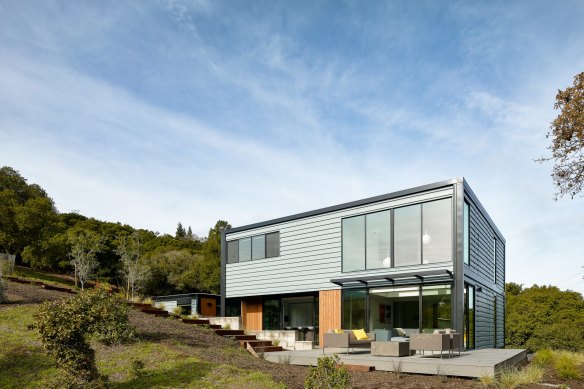This was published 7 months ago
Opinion
Prefab or pre-drab? The pros and cons of factory-made houses
Tone Wheeler
Australian Architecture Association presidentModular or prefab housing is the latest thought bubble from the federal government to help solve the housing crisis. It’s a beautiful idea, to make a whole house or apartment in a factory, and yet it’s failed to take off for 75 years. Why?
First, the upside.
It’s quicker. Prefab speeds up construction time; while the house is being built in a factory, the footings and infrastructure are built on-site. Time is big money in construction – lessening it can lower the overheads, making a house a bit cheaper.

Prefab speeds up construction time. Credit: CONNECT HOMES
It’s better built. The quality of workmanship is always better inside a factory, with its constant conditions, than on a site open to vagaries of the weather. The tools are better maintained, being secure in one place, not driven all over the city in vans and utes.
It’s safer. Working off a solid floor in a factory, with hoists and properly tagged tools is far better for the workers, with better lunchrooms, toilets and first aid than on a muddy site.
And it’s greener. Material is better controlled, less transport, less waste as the offcuts can be more efficiently recycled. Workers can catch public transport to a central factory, rather than driving all over the city to far-flung sites every day.
So, the big question is, if a factory-made house or apartment is better in so many ways than traditional building on muddy sites with variable weather, why the low take-up?
The downside with prefab is not the product itself, it’s everything else in the process. Australians might like the idea of prefab, but they don’t want a bar of it for their own house. And the financial system is stacked against it.
Aussies love “solid” houses. Concrete slab, masonry walls, tiled roofs. A continual reworking of the “Federation house”. But those heavy materials can only be built on-site, in traditional construction. In comparison, the “lightweight” materials in prefab manufacture are seen as just that: light weight. Thin and flimsy, it’s not “bricks and mortar”.
The recent rise in metal-clad mobile homes and shed-like “granny flats”, both mostly prefab, has done nothing to quell the disdain for the temporary, not-real-home feel. Add to that, our common experience of prefab is not great. The school “demountable”. Baking hot in summer, freezing in winter, acoustically horrible and an eyesore to boot. Or the irony that the contractors who build conventionally, work out of prefab site sheds. And can’t wait to get rid of them.
In that uncertain market, establishing a prefab business is a big risk. The factory, with its machinery and processes, is capital intensive. A huge expense before a single house is rolled out. Most firms that have ventured that capital rely on a steady diet of site sheds, mobile homes, and mining dongas to survive. Houses are a luxury that few have as their main manufacture.
But the financial risks don’t stop there for homeowners. Banks have the same conservative attitude to “solid construction” and don’t value prefab as highly, and critically won’t lend mortgage money to pay builders for material that’s off-site. With 90 per cent of the house value built in the factory, a separate, more expensive construction loan is required, increasing costs and complexity, and often wiping out the savings being made in the factory.
All of which has doomed volume assembly, or VOLA, using whole room modules, to the margins in Australian home-building.
But there is another prefab system that shows more promise – fabricating a house on site from large, standardised or custom-made components, in a “kit of parts assembly”, or KOPA.
In this system, a “flat pack” of whole floors, walls and roofs, with modules of bathrooms and kitchens, is delivered to site, for quick assembly. This is a logical extension of the existing manufacture of components such as wall frames, roof trusses, and fully glazed windows and doors. It’s not unlike the way a certain Swedish company has the purchaser assemble their furniture. And they now sell houses using the same system.
Given how widely dispersed and relatively small by world standards the Australian house building industry is, this seems a far more logical direction to go for prefab.
Tone Wheeler is president of the Australian Architecture Association and the design director of environa studio, which specialises in social and sustainable architecture.
Get a weekly wrap of views that will challenge, champion and inform your own. Sign up for our Opinion newsletter.